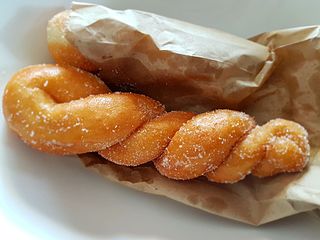
A doughnut or donut is a type of pastry made from leavened fried dough. It is popular in many countries and is prepared in various forms as a sweet snack that can be homemade or purchased in bakeries, supermarkets, food stalls, and franchised specialty vendors. Doughnut is the traditional spelling, while donut is the simplified version; the terms are used interchangeably.

Glutinous rice is a type of rice grown mainly in Southeast and East Asia, and the northeastern regions of South Asia, which has opaque grains, very low amylose content, and is especially sticky when cooked. It is widely consumed across Asia.

Malaysian cuisine consists of cooking traditions and practices found in Malaysia, and reflects the multi-ethnic makeup of its population. The vast majority of Malaysia's population can roughly be divided among three major ethnic groups: Malays, Chinese and Indians. The remainder consists of the indigenous peoples of Sabah and Sarawak in East Malaysia, the Orang Asli of Peninsular Malaysia, the Peranakan and Eurasian creole communities, as well as a significant number of foreign workers and expatriates.

Malay cuisine is the traditional food of the ethnic Malays of Southeast Asia, residing in modern-day Malaysia, Indonesia, Singapore, Brunei, Southern Thailand and the Philippines as well as Cocos Islands, Christmas Island, Sri Lanka and South Africa.

Coconut jam, also known as kaya jam or simply kaya, is a sweet spread made from a base of coconut milk, eggs, sugar and sometimes pandan leaves as a flavouring. It is popular throughout Southeast Asia.

Kuih are bite-sized snack or dessert foods commonly found in Southeast Asia and China. It is a fairly broad term which may include items that would be called cakes, cookies, dumplings, pudding, biscuits, or pastries in English and are usually made from rice or glutinous rice. In China, where the term originates from, kueh or koé (粿) in the Min Nan languages refers to snacks which are typically made from rice but can occasionally be made from other grains such as wheat. The term kuih is widely used in Malaysia, Brunei, and Singapore, kueh is used in Singapore and Indonesia, kue is used in Indonesia only, all three refer to sweet or savoury desserts.

Filipino cuisine is composed of the cuisines of more than a hundred distinct ethnolinguistic groups found throughout the Philippine archipelago. A majority of mainstream Filipino dishes that compose Filipino cuisine are from the food traditions of various ethnolinguistic groups and tribes of the archipelago, including the Ilocano, Pangasinan, Kapampangan, Tagalog, Bicolano, Visayan, Chavacano, and Maranao ethnolinguistic groups. The dishes associated with these groups evolved over the centuries from a largely indigenous base shared with maritime Southeast Asia with varied influences from Chinese, Spanish, and American cuisines, in line with the major waves of influence that had enriched the cultures of the archipelago, and adapted using indigenous ingredients to meet local preferences.

A buñuelo (Spanish:[buˈɲwelo], alternatively called boñuelo, bimuelo, birmuelo, bermuelo, bumuelo, burmuelo, or bonuelo, is a fried dough fritter found in Spain, Latin America, and other regions with a historical connection to Spaniards, including Southwest Europe, the Balkans, Anatolia, and other parts of Asia and North Africa. Buñuelos are traditionally prepared at Christmas. It will usually have a filling or a topping. In Mexican cuisine, it is often served with a syrup made with piloncillo.

A rice cake may be any kind of food item made from rice that has been shaped, condensed, or otherwise combined into a single object. A wide variety of rice cakes exist in many different cultures in which rice is eaten. Common variations include cakes made with rice flour, those made from ground rice, and those made from whole grains of rice compressed together or combined with some other binding substance.

Cascaron is a Filipino doughnut made of deep-fried ground glutinous rice, grated coconut, and sugar. They are commonly ball-shaped and are sold on skewers, but they can also be elongated, pancake-shaped, or doughnut-shaped. The name is derived from Spanish cascarón ("eggshell") due to its common spherical shape and crunchy exterior. It is not to be confused with cascarón, which is a hollowed-out chicken egg filled with prizes derived from the same term.

Kue is an Indonesian bite-sized snack or dessert food. Kue is a fairly broad term in Indonesian to describe a wide variety of snacks including cakes, cookies, fritters, pies, scones, and patisserie. Kue are made from a variety of ingredients in various forms; some are steamed, fried or baked. They are popular snacks in Indonesia, which has the largest variety of kue. Because of the countries' historical colonial ties, Koeé (kue) is also popular in the Netherlands.

In Vietnamese, the term bánh translates loosely as "cake" or "bread", but refers to a wide variety of prepared foods that can easily be eaten by hands or chopsticks. With the addition of qualifying adjectives, bánh refers to a wide variety of sweet or savory, distinct cakes, buns, pastries, sandwiches, and other food items, which may be cooked by steaming, baking, frying, deep-frying, or boiling. Foods made from wheat flour or rice flour are generally called bánh, but the term may also refer to certain varieties of noodle and fish cake dishes, such as bánh canh and bánh hỏi.

Puto is a Filipino steamed rice cake, traditionally made from slightly fermented rice dough (galapong). It is eaten as is or as an accompaniment to a number of savoury dishes. Puto is also an umbrella term for various kinds of indigenous steamed cakes, including those made without rice. It is a sub-type of kakanin.

Pichi-pichi, also spelled pitsi-pitsi, is a Filipino dessert made from steamed cassava flour balls mixed with sugar and lye. It is also commonly flavored with pandan leaves. It is served rolled in freshly grated coconut, cheese, or latik before serving.

Shakoy, also known as lubid-lubid or bicho bicho, is a traditional Filipino deep-fried twisted doughnut. It is traditionally made with flour, sugar, salt, and yeast and deep-fried. It is then sprinkled with white sugar. Variants of shakoy can also be made with other kinds of flour, most notably with rice flour, which results in a chewier version that is also usually coated with sesame seeds. Dry and crunchy versions of shakoy, which are usually much smaller, are known as pilipit.
Lokot-lokot or Locot-locot is a delicacy common in Mindanao and the Sulu Archipelago in the Philippines. It is also referred to as jaa in Sulu; tagaktak, tinagtag, tinadtag, or tinagaktak in Maguindanao, and amik in Davao del Sur. Its texture is crunchy, usually colored golden-brown. Lokot-Lokot is usually produced and served on special occasions such as the Muslim feast of Eid al-Fitr.

Twisted doughnuts are yeast donuts or sticks of pastry made from wheat flour or glutinous rice flour, deep-fried in oil. In China, they are known as mahua (麻花); in Korea, they are known as kkwabaegi in the Philippines, they are known as shakoy and pilipit, in Japan, they are known as sakubei.

Panyalam or panyam, is a traditional Filipino-Bangsamoro fried rice pancake. It is made with ground glutinous rice, muscovado, and coconut milk mixed into a batter that is deep-fried.

Cassava cake is a traditional Filipino moist cake made from grated cassava, coconut milk, and condensed milk with a custard layer on top. It is a very popular dish in the Philippines, where it is commonly eaten for merienda. It is also served during gatherings and special occasions.



















